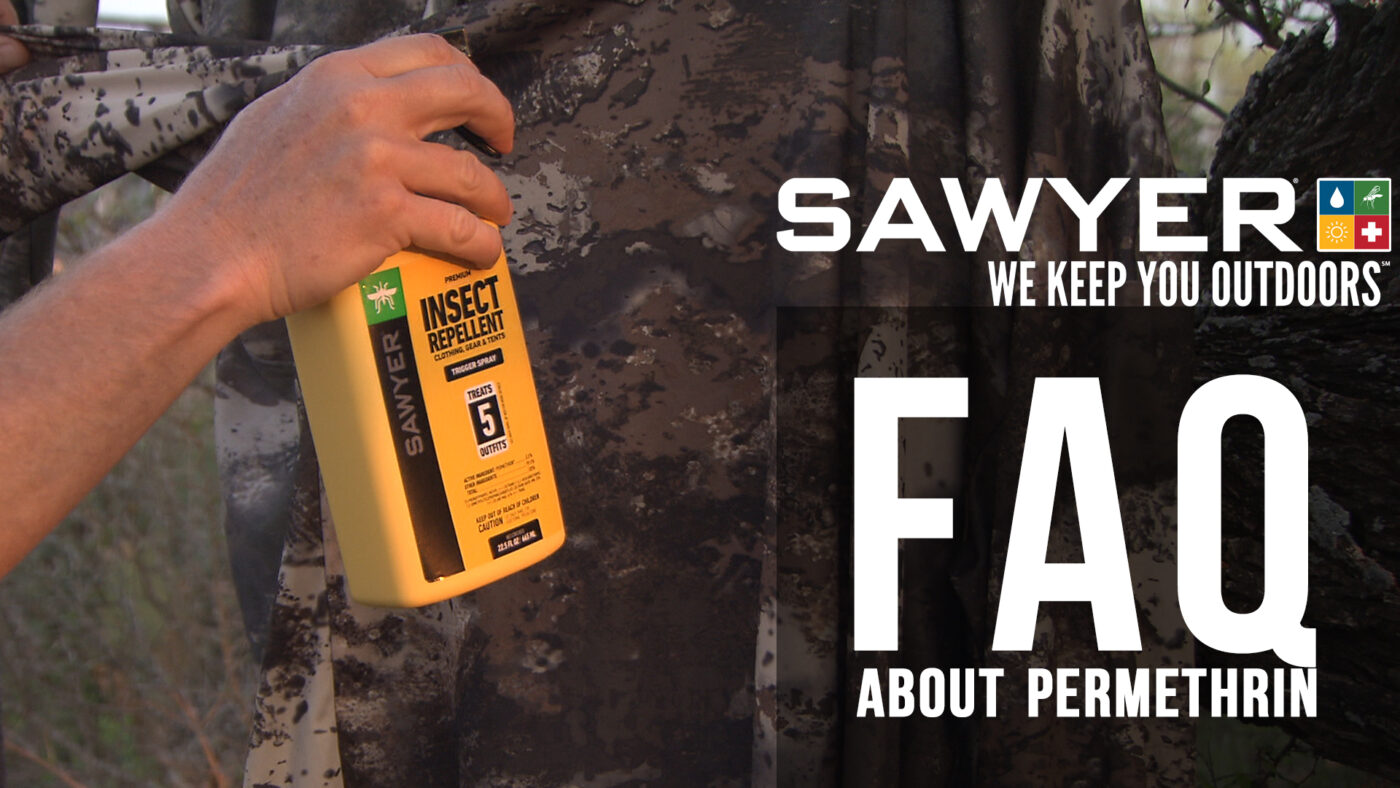We use Permethrin based insect repellents from Sawyer Products every time we go out hunting to prevent those disease-carrying insects like mosquitos and ticks from biting us. Let’s face it, we’ve all been sitting in our blinds witnessing the magical moment where our target animal has come into view only to be interrupted by the buzz and annoyance of a mosquito. Or having to leap from your chair and start swatting because someone said they found a tick.

We get a lot of questions about Permethrin Insect Repellents from our fans as they learn more about it. We thought we’d help answer those frequently asked questions with help from our friends at Sawyer. Let’s begin.
Q: What is Permethrin?
A: Permethrin is a synthetic version of the Chrysanthemum flower’s natural insect repellent pyrethrin. The naturally occurring version breaks down rather quickly in sunlight but Sawyer’s pharmaceutical grade, synthetic Permethrin can last 6 weeks or 6 washings on clothing and other fabrics, making it a fantastic odorless barrier of protection from mosquitoes and ticks.
Q: What is the shelf life of your insect repellent?
A: Our repellents don’t have an expiration date printed on them because they have a shelf life of 10 years when stored properly.
Q: Will Permethrin ruin my clothes or equipment?
A: No. Permethrin will not damage clothes or equipment. Unlike DEET, which may harm some fabrics and materials, Permethrin is compatible for use even on fragile fabrics such as silk, plus all synthetics and waterproof membrane fabrics. Permethrin will not affect plastics or finishes. IF IN DOUBT, try a sample on an obscure surface area, especially on delicates and check it after 24 hours of exposure.
Sawyer® Permethrin Insect Repellent is odorless, non-greasy and non-staining after it dries. Permethrin can be harmful to aquatic creatures such as fish, so do not spray Permethrin around fish aquariums.
Q: How do I use Permethrin Safely?
A: Permethrin is to be applied to clothing and material. It works by bonding to the fibers. When a tick or other insect comes into contact with the Permethrin, it absorbs a dose that will either repel or kill the insect. You apply Permethrin using an aerosol or trigger spray until the fabric is damp and then allow it to dry. Permethrin is easy to use and the resulting layer of protection is very important to your safety from insect-borne diseases.
Q: How long does Permethrin last?
A: At the concentration level delivered in the aerosol, non-aerosol pump sprays and soak systems (all at 0.5% Permethrin), an application lasts for six weeks and through six washings. Permethrin breaks down through exposure to air (oxygen) and sunlight (ultraviolet light). If you store the clothes in black plastic bags between uses, you can extend the time of effectiveness; however, always retreat after the sixth laundering. Permethrin may also be used on sleeping bags, tents and nettings.
Q: Does Permethrin work against mosquitos?
Yes. Permethrin clothing treatments, when applied following Directions for Use, have been determined to have “spatial repellency” against mosquitoes. This means that mosquitoes will swarm around you, but not light on your treated clothing and bite.
Also use an EPA registered repellent, such as the Sawyer® microencapsulated Controlled Release 20% DEET, on all exposed skin for further protection from biting and blood-sucking mosquitoes.
The combination of Permethrin on clothing and DEET repellent on skin forms an “Insect Repellent System.” When used as directed on the EPA registered labels, the Insect Repellent System will provide the best protection from biting, bloodsucking and disease-carrying insects. A well-known study conducted by Tom Lillie, Carl Schreck and A. J. Rahe in Alaska in 1987, showed 99.9% effectiveness against mosquitoes biting at a rate of more than 1,100/hr. This protection is far greater than either a DEET based insect repellent or Permethrin can achieve alone.

Q: Is Permethrin dangerous to my skin?
A: The warning labels on the cans or bottles are often misunderstood. Your skin metabolizes or breaks down, Permethrin within fifteen minutes of contact with skin. Therefore, it is of no value to you as a personal protection insect repellent when applied to the skin. In addition, the EPA precautionary statement, “Do Not Apply to Skin” indicates that Permethrin is ineffective when applied to the skin; therefore, do not apply to skin.
Q: How harmful are Permethrin fumes while treating clothing?
A: It is recommended that treating clothing with the permethrin aerosol be performed outdoors. If the treatment is accidentally carried out indoors, no adverse health effects are expected based upon calculations of inhaled dose. However, individuals with breathing problems, such as asthma, may be at greater risk. The odor arising from treating the fabric with permethrin is mostly from the aerosol propellants rather than from the insect repellent itself.
Q: How harmful is the wet Permethrin right after applying it to clothing?
The directions for applying permethrin from the aerosol can to clothing state that the fabric should be allowed to dry before wear or handling. However, contact with the wet material should pose minimal concern but should be washed off. The amount of permethrin available for skin absorption is very low and is not expected to cause adverse effects.
We’ll be posting more questions about Permethrin in the near future. Be sure to visit your local Bass Pro Shops and Cabela’s to pick up some Permethrin for your next trip into the outdoors. If you have a question about Sawyer’s Permethrin Insect Repellents feel free to reach out to us on our Facebook, Twitter, Instagram, or YouTube Page!





Leave a Reply